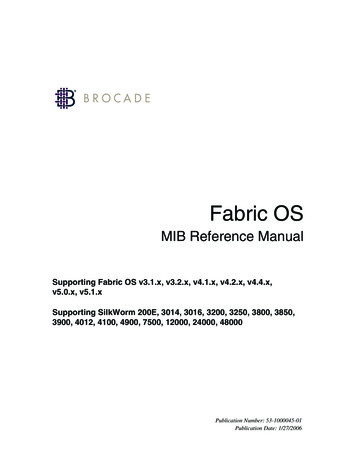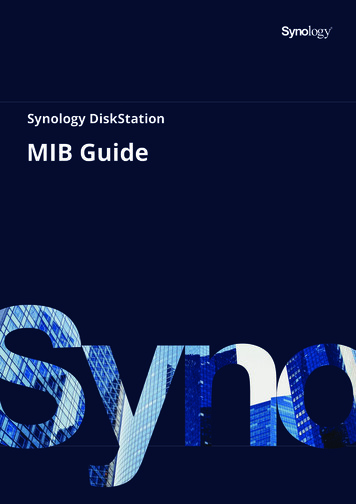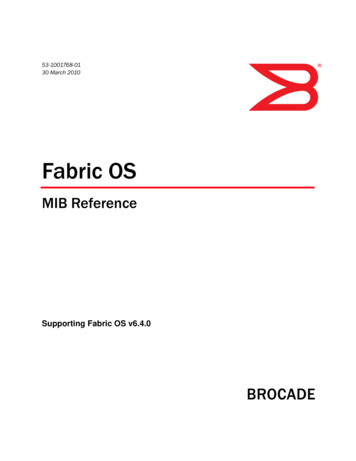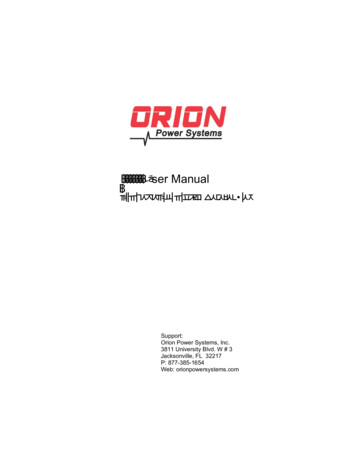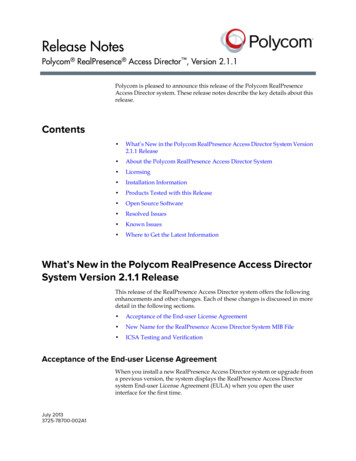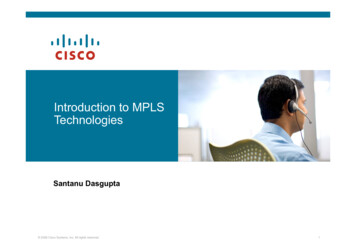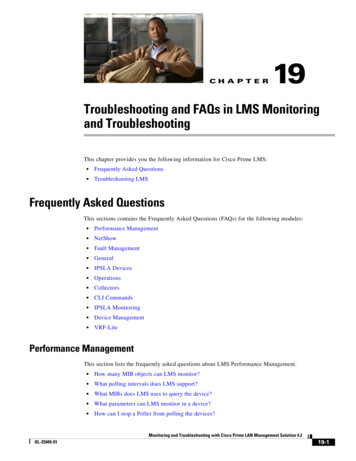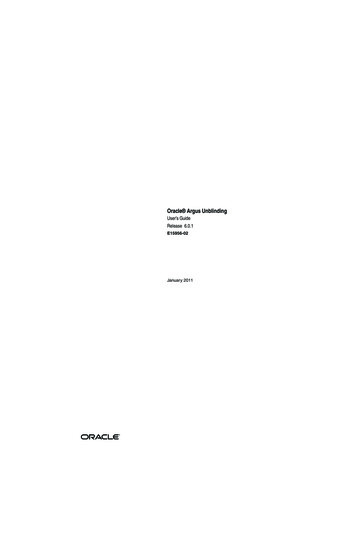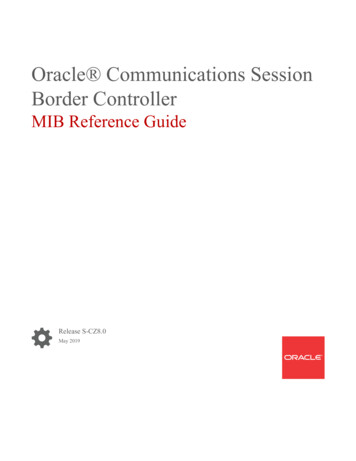
Transcription
Oracle Communications SessionBorder ControllerMIB Reference GuideRelease S-CZ8.0May 2019
Oracle Communications Session Border Controller MIB Reference Guide, Release S-CZ8.0Copyright 2014, 2019, Oracle and/or its affiliates. All rights reserved.This software and related documentation are provided under a license agreement containing restrictions on use anddisclosure and are protected by intellectual property laws. Except as expressly permitted in your license agreement orallowed by law, you may not use, copy, reproduce, translate, broadcast, modify, license, transmit, distribute, exhibit,perform, publish, or display any part, in any form, or by any means. Reverse engineering, disassembly, or decompilationof this software, unless required by law for interoperability, is prohibited.The information contained herein is subject to change without notice and is not warranted to be error-free. If you findany errors, please report them to us in writing.If this is software or related documentation that is delivered to the U.S. Government or anyone licensing it on behalf ofthe U.S. Government, then the following notice is applicable:U.S. GOVERNMENT END USERS: Oracle programs, including any operating system, integrated software, anyprograms installed on the hardware, and/or documentation, delivered to U.S. Government end users are "commercialcomputer software" pursuant to the applicable Federal Acquisition Regulation and agency-specific supplementalregulations. As such, use, duplication, disclosure, modification, and adaptation of the programs, including any operatingsystem, integrated software, any programs installed on the hardware, and/or documentation, shall be subject to licenseterms and license restrictions applicable to the programs. No other rights are granted to the U.S. Government.This software or hardware is developed for general use in a variety of information management applications. It is notdeveloped or intended for use in any inherently dangerous applications, including applications that may create a risk ofpersonal injury. If you use this software or hardware in dangerous applications, then you shall be responsible to take allappropriate fail-safe, backup, redundancy, and other measures to ensure its safe use. Oracle Corporation and its affiliatesdisclaim any liability for any damages caused by use of this software or hardware in dangerous applications.Oracle and Java are registered trademarks of Oracle and/or its affiliates. Other names may be trademarks of theirrespective owners.Intel and Intel Xeon are trademarks or registered trademarks of Intel Corporation. All SPARC trademarks are used underlicense and are trademarks or registered trademarks of SPARC International, Inc. AMD, Opteron, the AMD logo, andthe AMD Opteron logo are trademarks or registered trademarks of Advanced Micro Devices. UNIX is a registeredtrademark of The Open Group.This software or hardware and documentation may provide access to or information about content, products, andservices from third parties. Oracle Corporation and its affiliates are not responsible for and expressly disclaim allwarranties of any kind with respect to third-party content, products, and services unless otherwise set forth in anapplicable agreement between you and Oracle. Oracle Corporation and its affiliates will not be responsible for any loss,costs, or damages incurred due to your access to or use of third-party content, products, or services, except as set forth inan applicable agreement between you and Oracle.
ContentsAbout this Guide1IntroductionAbout MIBs1-1Object Identifiers and Instance IDs1-1MIB Tree Structure1-2Managed Objects1-3Scalar MIB Objects1-3Table MIB Objects1-3SNMP TrapsMIBs Supported1-31-3Standard MIBS1-4Enterprise MIBs1-4Traps1-5Standard Traps1-5Enterprise Traps1-6apApps Traps (ap-apps.mib)1-6apAclDropOverThresholdTrap Objects1-6apDiameter Traps (ap-diameter.mib)1-7apDnsAlg Traps (ap-dnsalg.mib)1-7apEnvMon Traps (ap-env-monitor.mib)1-8apH323 Traps (ap-h323.mib)1-8apLicense Traps (ap-license.mib)1-8apSecurity Traps (ap-security.mib)1-8apSip Traps (ap-sip.mib)1-10apSyslog Traps (ap-slog.mib)1-10apSysMgmt Traps (ap-smgmt.mib)1-10apUSBC Traps (ap-usbcsys.mib)1-20EMS TrapsSNMPv3 Secure TrapsAuthentication and PrivacyPassword-to-Key Conversion1-201-211-211-22iii
Enabling SNMPv31-22Consideration for HA Nodes1-22Complete SNMPv3 Configuration1-23SNMPv3 Configuration1-23Users and Password for SNMPv3 Configuration1-23Adding Authorized Trap Receivers1-24Persistent indexing of SNMP Tables1-24Log Levels and syslog Level Severities1-25Log Levels1-25syslog Level Severities1-26Mapping Trap Filter Levels to syslog and Alarm Severities1-26Platform sysObjectIDs2Standard SNMP GET RequestsInterfaces ObjectInterface TableInterface Description in MIB2-12-12-3ifXTable Table2-4ip Object2-7ipAddrTable Table2-8icmp Object2-9TCP Object2-10tcpConnTable Table2-11UDP Object2-12System Object2-12Object Resource Information Object31-272-13SNMP Object2-14Physical Entity Table2-15Enterprise SNMP GET RequestsApplications MIB (ap-apps.mib)3-1apAppsENUMServerStatusTable Table3-1apAppsDnsServerStatusTable3-1Codec and Transcoding MIB ng Capacity in System Management MIB (ap-smgmt.mib)3-6Diameter MIB (ap-diameter.mib)3-6DNS ALG MIB (ap-dnsalg.mib)3-7apDNSALGServerStatusTable3-7iv
apDNSALGStatsTableEnvironment Monitor MIB (ap-env-monitor.mib)3-10H.323 MIB (ap-h323.mib)3-14License MIB (ap-license.mib)3-14Security MIB 0SIP MIB (ap-sip.mib)3-21syslog MIB (ap-slog.mib)3-22System Management MIB (ap-smgmt.mib)3-24Notes on ENUM Server Names43-40Software Inventory MIB (ap-swinventory.mib)3-41Multicore Monitoring MIB (ap-usbcsys.mib)3-42SNMP-based Application FeaturesSNMP Reporting of Message Rate numServerRateStatsTable4-2FQDN-resolved Session Agent Statistics SNMP Retrieval4-2CAC Utilization Statistics via SNMP4-3SNMP Get for CAC Utilization4-3CAC Utilization Traps4-5External Policy Server Connection Status ReportingA3-84-5System AlarmsAlarm SeveritiesA-14v
About this GuideAbout this GuideThe Oracle Communications Session Border Controller MIB Reference Guide providesinformation about the following: Management Information Base (MIBs) Acme Packet’s enterprise MIBs General trap information, including specific details about standard traps and enterprisetraps Simple Network Management Protocol (SNMP) GET query information, includingstandard and enterprise SNMP GET query names, object identifier names and numbers,and descriptions This guide also describes the correlation between system alarms and the MIBs that supporttraps, and it provides reference information about log levels, syslog level severities (theprotocol used for the network logging of system and network events), and trap receiverfilter levels. Appendix A contains several trap examples. Appendix B contains the locationof documents where you can obtain more information.Related DocumentationThe following table describes the documentation set for this release.Document NameDocument DescriptionAcme Packet 4600 Hardware InstallationGuideContains information about the components andinstallation of the Acme Packet 4600.Acme Packet 6100 Hardware InstallationGuideContains information about the components andinstallation of the Acme Packet 6100.Acme Packet 6300 Hardware InstallationGuideContains information about the components andinstallation of the Acme Packet 6300.Acme Packet 6350 Hardware InstallationGuideContains information about the components andinstallation of the Acme Packet 6350.Release NotesContains information about the current documentation setrelease, including new features and management changes.ACLI Configuration GuideContains information about the administration andsoftware configuration of the Service Provider OracleCommunications Session Border Controller.ACLI Reference GuideContains explanations of how to use the ACLI, as analphabetical listings and descriptions of all ACLIcommands and configuration parameters.Maintenance and Troubleshooting GuideContains information about Oracle CommunicationsSession Border Controller logs, performanceannouncements, system management, inventorymanagement, upgrades, working with configurations, andmanaging backups and archives.vi
About this GuideDocument NameDocument DescriptionMIB Reference GuideContains information about Management Information Base(MIBs), Oracle Communication's enterprise MIBs, generaltrap information, including specific details about standardtraps and enterprise traps, Simple Network ManagementProtocol (SNMP) GET query information (includingstandard and enterprise SNMP GET query names, objectidentifier names and numbers, and descriptions), examplesof scalar and table objects.Accounting GuideContains information about the Oracle CommunicationsSession Border Controller’s accounting support, includingdetails about RADIUS and Diameter accounting.HDR Resource GuideContains information about the Oracle CommunicationsSession Border Controller’s Historical Data Recording(HDR) feature. This guide includes HDR configurationand system-wide statistical information.Administrative Security EssentialsContains information about the Oracle CommunicationsSession Border Controller’s support for its AdministrativeSecurity license.Security GuideContains information about security considerations andbest practices from a network and application securityperspective for the Oracle Communications SessionBorder Controller family of products.Installation and Platform Preparation Guide Contains information about upgrading system images andany pre-boot system provisioning.Call Traffic Monitoring GuideContains information about traffic monitoring and packettraces as collected on the system. This guide also includesWebGUI configuration used for the SIP Monitor and Traceapplication.Header Manipulation Rule GuideContains information about configuring and using HeaderManipulation Rules to manage service traffic.Revision HistoryDateDescriptionSeptember, 2017 Initial ReleaseMay 2018 Updates the "ifXTable Table" description foraccuracy.June 2018 Adds the Comm Monitor down and CommMonitor clear traps to "apApps Traps," andComm Monitor connection down to "SystemAlarms."May 2019 Updates apSysGlobalCPS description foraccuracy.Moves apAppsAclObjects table to "EnterpriseTraps." vii
1IntroductionThis chapter describes Management Information Bases (MIBs) and the correlation betweensystem alarms and the MIBs that support traps. It also provides reference information about loglevels, syslog level severities (the protocol used for the network logging of system and networkevents), and trap receiver filter levels.About MIBsEach network device managed by SNMP must have a MIB that describes its manageableobjects. MIBs are collections of objects or definitions that define the properties of the managedobjects. Each managed object has specific characteristics.The manager relies upon the database of definitions and information about the properties ofmanaged resources and the services the agents support. When new agents are added to extendthe management domain of a manager, the manager must be provided with a new MIBcomponent that defines the manageable features of the resources managed through that agent.The data types and the representations of resources within a MIB, as well as the structure of aparticular MIB, are defined in a standard called the Structure of Management Information(SMI).Object Identifiers and Instance IDsEach managed object/characteristic has a unique object identifier (OID) consisting of numbersseparated by decimal points (for example, 1.3.6.1.4.1.9148.1); numeric OIDs can also betranslated into human-readable form. The MIB associates each OID with a readable label andvarious other parameters related to the object. The OID identifies the location of a givenmanaged object within the MIB tree hierarchy by listing the numbers in sequence from the topof the tree down to the node, separated by dots.By specifying a path to the object through the MIB tree, the OID allows the object to beuniquely identified. The digits below the enterprise OID in the tree can be any sequence ofuser-defined numbers chosen by an organization to represent its private MIB groups andmanaged objects.An instance ID identifies developments that have occurred for the managed object. Theinstance ID values are represented as a combination of the OID and the table index. Forexample, you can find the following instance ID in the TCP connection table:tcpConnState.127.0.0.1.1024.127.0.0.1.3000 tcpConnState is the OID 127.0.0.1 is an IPv4 address 1024 is the port number 127.0.0.1 is another IPv4 address 3000 is another port number1-1
Chapter 1About MIBsMIB Tree StructureMIBs are arranged in a tree-structured fashion, similar in many ways to a operating systemdirectory structure of files. The following diagram illustrates a MIB tree with a sample of thestandard MIBs shown under the mib-2 node and a sample of a system management enterpriseMIB under the enterprise node. (The listing is only a partial sample of the MIB contents.)The diagram shows how the OID is a concatenation of the prior addresses up to that point. Forexample, the OID for apSysCPUUtil is 3.6internet(1)directory(1)mgmt(2)mib-2(1)systems (1)Interfaces (2)ip (4)icmp (5)tcp (6)udp rise(1)1.3.6.1.4.1acmepacket(9148)acmePacketMgmt (3)apSystemManagementModule (2)apSysMgmtMIBObjects (1)apSysMgmtGeneralObjects (1)apSysCPUUtil (1)apSysMemoryUtil (2)apSysHealthScore (3)apSysRedundancy 2.1.1.4The diagram shows the Acme Packet node has the value 9148; this is Oracle's vendor-specificnumber that uniquely identifies an Acme Packet product MIB. This node is the highest level of1-2
Chapter 1MIBs Supportedthe private (proprietary) branch containing Acme Packet managed objects. The number 9148was assigned by the Internet Assigned Numbers Authority (IANA).Managed ObjectsManaged objects are made up of one or more object instances, which are essentially variables.Managed objects can be scalar (defining a single object instance) or tabular (defining multiple,related instances).Scalar MIB ObjectsScalar MIB objects contain one precise piece of data (also referred to as discrete). Theseobjects are often distinguished from the table objects by adding a .0 (dot-zero) extension totheir names. Many SNMP objects are scalar. That is, the operator merely has to know the nameof the object and no other information. Discrete objects often represent summary values for adevice, particularly useful for scanning information from the network for the purposes ofcomparing network device performance. If the extension (instance number) of the object is notspecified, it can be assumed as .0 (dot-zero). See the Enterprise SNMP Get Requests chapterfor examples of scalar MIB objects.Table MIB ObjectsTable MIB objects contain multiple pieces of management data. These objects are distinguishedfrom the scalar objects by requiring a . (dot) extension to their names that uniquelydistinguishes the particular value being referenced. The . (dot) extension is also referred as theinstance number of an SNMP object. In the case of table objects, this instance number is theindex into the SNMP table. (In the case of scalar objects, this instance number is zero.)SNMP tables allow parallel information to be supported. Tables are distinguished from scalarobjects, in that tables can grow without bounds. For example, SNMP defines the ifDescr objectas a standard SNMP object, which indicates the text description of each interface supported bya particular device. Since network devices can be configured with more than one interface, thisobject could only be represented as an array. By convention, SNMP objects are always groupedin an Entry directory, within an object with a Table suffix. (The ifDescr object described aboveresides in the ifEntry directory contained in the ifTable directory.) See the Enterprise SNMPGet Requests chapter for examples of table MIB objects.SNMP TrapsThe MIB also contains information about SNMP traps, which enable an agent to notify themanagement station of significant events by way of an unsolicited SNMP message. When anelement sends a TRAP packet, it can include OID and value information (bindings) to clarifythe event.MIBs SupportedThe system supports both standard MIBs and Oracle-specific MIBs (enterprise MIBs). Theconfigurable system elements are identified in the MIBs provided by Oracle. Every systemmaintains a database of values for each of the definitions written in these MIBs.1-3
Chapter 1MIBs SupportedStandard MIBSThe values in the standard MIBs are defined in RFC-1213, (one of the governing specificationsfor SNMP). A standard MIB includes objects to measure and monitor IP activity, TCP activity,UDP activity, IP routes, TCP connections, interfaces, and general system description. Each ofthese values is associated both an official name (such as sysUpTime, which is the elapsed timesince the managed device was booted) and a numeric value expressed in dot-notation (such as1.3.6.1.2.1.1.3.0, which is the OID for sysUpTime).Oracle provides the following standard MIBs: rfc3411-framework.mib rfc1907-snmpv2.mib rfc2011-ip.mib rfc2737-entity.mib rfc2863-if.mib (Oracle supports the ifName entry of the ifXTable, which is an extension tothe interface table and which replaces ifExtnsTable. See RFC 2863 for details.) ianaiftype.mib rfc4001-inetAddr.mib rfc4022-tcp.mib rfc4113-udp.mibEnterprise MIBsOracle provides the following enterprise MIBs:MIB NameDescriptionap-agentcapability.mibDetails the SNMP agent’s capabilities that includes support for differentmodules: SNMPv2 capabilities support the SNMPv2 MIB and include thesystemGroup, snmpGroup, snmpCommunityGroup, andsnmpBasicNotificationsGroup variables. MIB-II capabilities support MIB-II and include the User DatagramProtocol (UDP)-MIB (udpGroup) variables and some, but not allof the IF-MIB (ifGeneralGroup and ifPacketGroup), IP-MIB(ipGroup and icmpGroup), and TCP-MIB (tcpGroup) variables.For more information about which variables are currentlysupported, refer to the ap-agentcapability.mib file. MIB capabilities include support for the contents of the MIBslisted in this table. Refer to the individual MIBs for details.ap-ami.mibManagement interface on the SBC.ap-codec.mibCodec and transcoding information generated by systems.ap-ems.mibEMS traps.ap-entity-vendortype.mibOID assignments for Acme Packet hardware components.ap-env-monitor.mibFan speed, voltage, temperature, and power supply for the system. Italso sends out traps when status changes occur.ap-license.mibStatus of your licenses.ap-products.mibDescriptions of the different SBC versions.1-4
Chapter 1TrapsMIB NameDescriptionap-security.mibInformation about the Acme Management Interface running on theSBC.ap-slog.mibsyslog messages generated by the system via SNMP. Used for thenetwork logging of system and network events, the syslog protocolfacilitates the transmission of event notification messages acrossnetworks. The syslog MIB can also be used to allow remote log access.The SNMP system manager references syslog to find out about any andall syslog messages.If the following conditions are present, the SNMP agent sends anSNMP trap when a message is sent to the syslog system: The system configurations’s snmp-enabled parameter is set toenabled. The system configuration’s enable-snmp-syslog-notify parameteris set to enabled. The actual syslog severity level is of equal or greater severity thanthe severity level configured in the system config’s snmp-sysloglevel field.No trap is sent under the following conditions: A syslog event is generated and the system config’s enable-snmpsyslog-notify parameter is set to disabled.The actual syslog severity level is of lesser severity (for example,higher numerical code value) than the severity level configured inthe system config’s snmp-syslog-level parameter.ap-smgmt.mibStatus of the system (for example, system memory or system health).ap-smi.mibGeneral information about the system’s top-level architectural design.ap-swinventory.mibStatus of the boot images, configuration information, and bootloaderimages for the system.ap-tc.mibTextual conventions used in enterprise MIBs.TrapsA trap is initiated by tasks to report that an event has happened on the system. SNMP trapsenable an SNMP agent to notify the NMS of significant events using an unsolicited SNMPmessage.Oracle uses SNMPv2c. These notification definitions are used to send standard and enterprisetraps.Traps are sent according to the criteria established in the following: IETF RFC 1907 Management Information Base for Version 2 of the Simple NetworkManagement Protocol IETF RFC 2233 The Interfaces Group MIB using SMIv2 Appropriate enterprise MIB (for example the syslog MIB or the System ManagementMIB).Standard TrapsThe following table identifies the standard traps that the system supports.1-5
Chapter 1TrapsTrap NameDescriptionlinkUpThe SNMPv2 agent detects that the ifOperStatus object of an interface hastransferred from the down state to the up state. The ifOperStatus value indicatesthe other state.linkDownThe SNMPv2 agent detects that the ifOperStatus object of an interface hastransferred from the up state to the down state. The ifOperStatus value indicatesthe other state.coldStartThe SNMPv2 agent is reinitializing itself and its configuration may have beenaltered.This trap is not associated with a system alarm.authenticationFailure The SNMPv2 agent received a protocol message that was not properlyauthenticated. If the snmp-enabled and enable-snmp-auth-traps fields in theACLI's system-config element are set to enabled a snmpEnableAuthenTrapsobject is generated.This trap is not associated with a system alarm.Enterprise TrapsThe following sections list traps available on the Oracle Communications Session BorderController. Traps are divided by the mib file they are contained within.apApps Traps (ap-apps.mib)The ap-apps.mib includes the following rap1.3.6.1.4.1.9148.3.16.2.2.1.0.1Generated if the reachability status of an ENUMserver .9148.3.16.2.2.2.0.1Generated if the reachability status of a DNS 1.9148.3.16.2.2.4.0.1Generated when the acl drop ratio exceeds theconfigured .1.9148.3.16.2.2.4.0.2Generated when the acl drop ratio goes below theconfigured 48.3.16.2.2.3.0.1Generated when there is a disconnect between aSession Border Controller and a .9148.3.16.2.2.3.0.2Generated when a Session Border Controllerreconnects with the CommMonitor and normaloperation resumes.apAclDropOverThresholdTrap ObjectsThe following objects, which are part of the apAclDropOverThresholdTrap, are not availablewith an SNMP GET.MIB ObjectObject ID1.3.6.1.4.1.9148.3.16.4 DescriptionapAclDropType.1ACL drop type.1-6
Chapter 1TrapsMIB ObjectObject ID1.3.6.1.4.1.9148.3.16.4 DescriptionapAclDropCount.2ACL drop count within monitortime window.apAclDropRatio.3ACL drop ratio as permillage ofcurrent time window.apDiameter Traps (ap-diameter.mib)The following traps are found in pTrap:.1.3.6.1.4.1.9148.3.13.1.2.2.0.1Generated when a Diameter Accounting Servergoes 3.1.2.2.0.2Generated when a Diameter Accounting Servergoes 1.2.2.0.3Generated when the accounting message queue isfull and all accounting servers are 3.13.1.2.2.0.4Generated when the apAcctMsgQueueFullTrapcondition 148.3.13.1.2.2.0.5Generated when the Diameter Server returns 3xxx(Protocol Errors), 4xxx (Transient Failures), or5xxx (Permanent Failure) Result-Code AVP 9148.3.13.1.2.2.0.6After an error result, generated when the DiameterServer returns a 2xxx (Success) Result-Code AVP(268).apDnsAlg Traps (ap-dnsalg.mib)The following traps are found in rap1.3.6.1.4.1.9148.3.14.2.2.0.1Generated if the reachability status of an DNSALG server changes from In-Service to eitherTimed out or Out of 148.3.14.2.2.0.2Generated if the reachability status of an DNSALG server changes from either Timed out or Outof Service to 1.4.1.9148.3.14.2.2.0.3Generated if a DNS-ALG configuration object'sconstraints state changes from In-Service toConstraints .6.1.4.1.9148.3.14.2.2.0.4Generated if a DNS-ALG configuration object'sconstraints state changes from ConstraintsExceeded to .6.1.4.1.9148.3.14.2.2.0.5Generated if a DNS Server (i.e. IP-Address)constraints state changes from In-Service toConstraints 1.3.6.1.4.1.9148.3.14.2.2.0.6Generated if a DNS Serve (i.e. IP-Address)constraints state changes from ConstraintsExceeded to In-Service.1-7
Chapter 1TrapsapEnvMon Traps (ap-env-monitor.mib)The following traps are found in ap-env-monitor.mib. They are used generally forreporting on environmental :1.3.6.1.4.1.9148.3.3.4.0.1Sent when the Inter-IC bus (I2C) state changesfrom normal (1) to not functioning 8.3.3.4.0.5For the AP4500 only. Generated if a physical portis inserted/present or removed/not .1.9148.3.3.4.0.2Sent when any entry of any environment monitortable changes in the state of a device beingmonitored. To receive this trap, you need to set thesystem config’s enable- env- monitor- table valueto enabled.apH323 Traps (ap-h323.mib)The following traps are found in ap-env-h323.mib. They are used generally for reportingon environmental Trap:1.3.6.1.4.1.9148.3.10.3.0.1Generated when the number of H.323 callsincreases the percentage of the max calls .6.1.4.1.9148.3.10.3.0.2Generated when the number of H.323 callsdecreases to below the lowest max calls threshold.apLicense Traps (ap-license.mib)The following traps are found in ap-license.mib. They are used generally for reporting onenvironmental yNotification:1.3.6.1.4.1.9148.3.5.3.0.1Generated when the total number of active sessionson the system (across all protocols) is within 98 100% of the licensed on:1.3.6.1.4.1.9148.3.5.3.0.2Generated when the total number of active sessionson the system (across all protocols) has gone to orbelow 90% of its licensed capacity (but no soonerthan 15 seconds after the original alarm on1.3.6.1.4.1.9148.3.5.3.0.3This trap is sent when a license is within 7 days ofexpiration.apSecurity Traps (ap-security.mib)The following traps are found in ap-security.mib.1-8
Chapter cation:1.3.6.1.4.1.9148.3.9.3.1.0.1Generated when an IPSec IKEV2 tunnel cannot 6.1.4.1.9148.3.9.3.2.0.1Generated when an IPSec IKEV2 tunnel failsbecause of Dead Peer Detection .9148.3.9.3.4.0.1Generated when an invalid CRL is 4.1.9148.3.9.3.6.0.1This trap is generated periodically if a locallyinstalled certificate has expired. The interval ofminutes between this trap being generated isconfigured in the s trap is generated if a locally installedcertificate will soon expire. The number of daysbefore expiration in which this trap is sent isconfigured in the enerated when TACACS authentication requestfails due to one of the following reasons: a TACACS daemon becomes unreachable an unreachable TACACS daemon becomesreachable an authentication error occurs an authorization error cme Packet Agent Capability for enterprise TSCFSecurity .2.13Collection of MIB objects for the collection ofTSCF 4.1.9148.3.9.4.3.11Collection of notifications for TSCF resource 1.9148.3.9.3.8.0.1 /These notifications are sent when the available IPaddresses in TSCF address pool depletes below theconfigured threshold level, then increases above theconfigured threshold level. The configuration MIBobjects involved (1.3.6.1.4.1.9148.3.9.1.15.1.1) 1.9148.3.9.2.29).The statistical MIB objects involved 48.3.9.1.15.1.3) andap
The information contained herein is subject to change without notice and is not warranted to be error-free. If you find any errors, please report them to us in writing. . Log Levels and syslog Level Severities 1-25 Log Levels 1-25 . Notes on ENUM Server Names 3-40 Software Inventory MIB (ap-swinventory.mib) 3-41 Multicore Monitoring MIB (ap .
